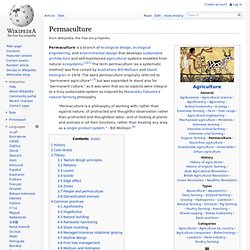

Nine Layers of the Edible Forest Garden (Food Forest) Food Forests have been around for thousands of years in tropical and sub-tropical climates.

In fact, there is a Food Forest currently still producing food in Morocco that was established 2,000 years ago! The concept of food forestry was almost lost to the annals of history when Robert Hart decided to adapt this design to his temperate climate in the UK in the 1960′s. The idea of a Forest Garden was brought to the public’s awareness when Robert wrote a book documenting his grand experiment. Bill Mollison, the co-founder of Permaculture, visited Robert’s site in 1990, and he quickly adopted this design element into his teachings and work. Initially, when Robert Hart described the layers of the Forest Garden, I believe he did so based on what he had and what he studied.
Until now. I am not actually arguing about the existing layers. Here are my Nine Layers of the Edible Forest Garden: 1. 2. 3. 4. 5. 6. 7. 8. Companion planting gardening plants. Beginner's Guide to Companion Planting. Permaculture. Permaculture is a branch of ecological design, ecological engineering, and environmental design that develops sustainable architecture and self-maintained agricultural systems modeled from natural ecosystems.[1][2] The term permaculture (as a systematic method) was first coined by Australians Bill Mollison and David Holmgren in 1978.

The word permaculture originally referred to "permanent agriculture" [3] but was expanded to stand also for "permanent culture," as it was seen that social aspects were integral to a truly sustainable system as inspired by Masanobu Fukuoka's natural farming philosophy. "Permaculture is a philosophy of working with, rather than against nature; of protracted and thoughtful observation rather than protracted and thoughtless labor; and of looking at plants and animals in all their functions, rather than treating any area as a single product system.
" - Bill Mollison [4] History[edit] Core tenets[edit] The core tenets of permaculture are:[9][10][11] Theory[edit] Permacultureprinciples. Bird canopy layers. Layerd Farming. Forest gardening. History[edit] Forest gardens are probably the world's oldest form of land use and most resilient agroecosystem.[2][3] They originated in prehistoric times along jungle-clad river banks and in the wet foothills of monsoon regions.

In the gradual process of families improving their immediate environment, useful tree and vine species were identified, protected and improved whilst undesirable species were eliminated. Eventually superior foreign species were selected and incorporated into the gardens.[4] Forest gardens are still common in the tropics and known by various names such as: home gardens in Kerala in South India, Nepal, Zambia, Zimbabwe and Tanzania; Kandyan forest gardens in Sri Lanka;[5] huertos familiares, the "family orchards" of Mexico; and pekarangan, the gardens of "complete design", in Java.[6] These are also called agroforests and, where the wood components are short-statured, the term shrub garden is employed.
In tropical climates[edit] Americas[edit]